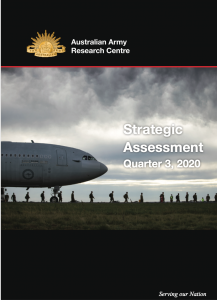Australian Army Strategic Assessment: Fall 2020
There is a widespread lack of confidence in data concerning the impact of COVID-19, warranting ‘warlike’ government intervention in the economy.
Economic problems are creating conditions for nation states to act with ‘hardening’ self-interest. Australia’s forecast economic downturn has now transitioned into recession.
Human security costs from the COVID-19 pandemic will influence state fragility and increasingly create the conditions for conflict in our immediate region and across the Indo-Pacific.
This AARC Q3 Strategic Assessment acknowledges resilience as an emerging theme relevant to land power’s contribution to Australian strategy.
Introduction
Paraphrasing Winston Churchill, the Australian Army Research Centre (AARC) Quarter 3 (Q3) 2020 Strategic Assessment begins by acknowledging Australia is coming to the end of the beginning of the COVID-19 pandemic. In early September the world moved past 850,000 COVID-19 attributable deaths.
Australia’s COVID-19 experience accounts for 657 of these deaths as individual, state and territory governments seek to suppress and in some circumstances eliminate the virus within their respective borders, irrespective of the Federal Government’s intent to drive economic recovery as a national effort.
The Australian economy is now in an official recession as global pandemic-related lockdowns bite economic activity, with an approximate 7% fall in Australia’s real GDP in the June quarter. The Australian Government notes this is an exceptional result given the ‘World Bank is expecting more economies to experience contractions in per capita GDP than at any other time since 1870’.
Meanwhile, analysts across the world continue to write papers, articles and commentary discussing the impact of the pandemic on the geostrategic balance between nations. The 2020 Defence Strategic Update (DSU), released at the beginning of this quarter, describes this uncertainty.
The Australian Government believes that the nation now finds itself in a period of strategic competition, within a region ‘in the midst of the most consequential strategic realignment since the Second World War’.
This environment is described as paralleling the conditions of the Cold War, the main difference being the geographic epicentre is no longer continental Europe but the Indo-Pacific
. Consequently, ‘Government has directed Defence to implement a new strategic policy framework signalling Australia’s ability—and willingness—to project military power to deter actions against us.
The purpose of this Strategic Assessment is to analyse the trends influencing decisions pertaining to Army’s force design, structure and posture. It focuses upon risks and possible responses to trends and circumstances. The Q2 Strategic Assessment introduced the themes of balancing jurisdiction and capability (as a result of Operation Bushfire Assist); an economic crisis (as a result of the COVID-19 pandemic); and an acceleration of strategic competition.
These themes are in turn linked to a fourth identified in this Strategic Assessment: resilience, a reflection of how the nation responds to shocks. This assessment contends that understanding the drivers of resilience is fundamental to understanding Army’s role in deterrence, as well as its relationship with other arms of government, when supporting federal and state responses to significant events.

The Australian Army strategic assessment can be found as a PDF here:
https://researchcentre.army.gov.au/library/other/strategic-assessment-quarter-3-2020
Or as an ebook below:
